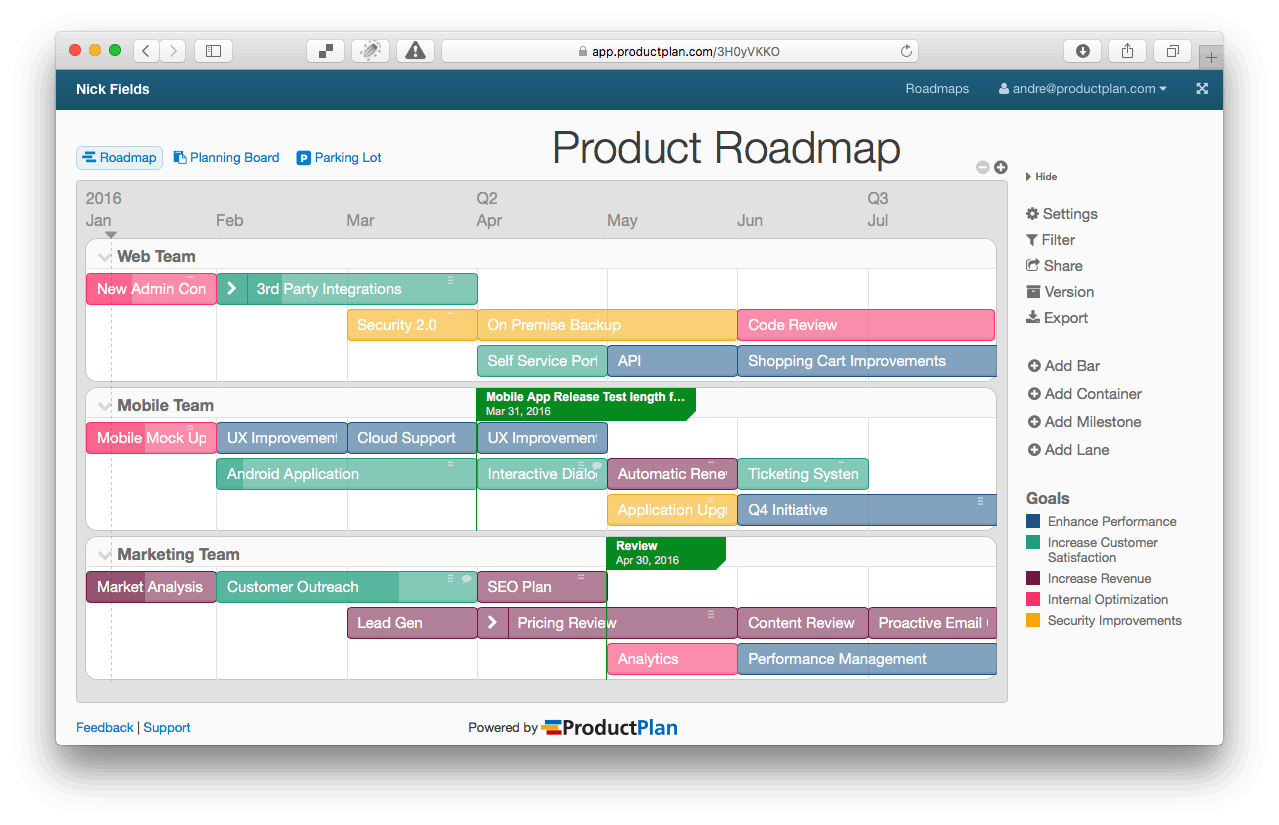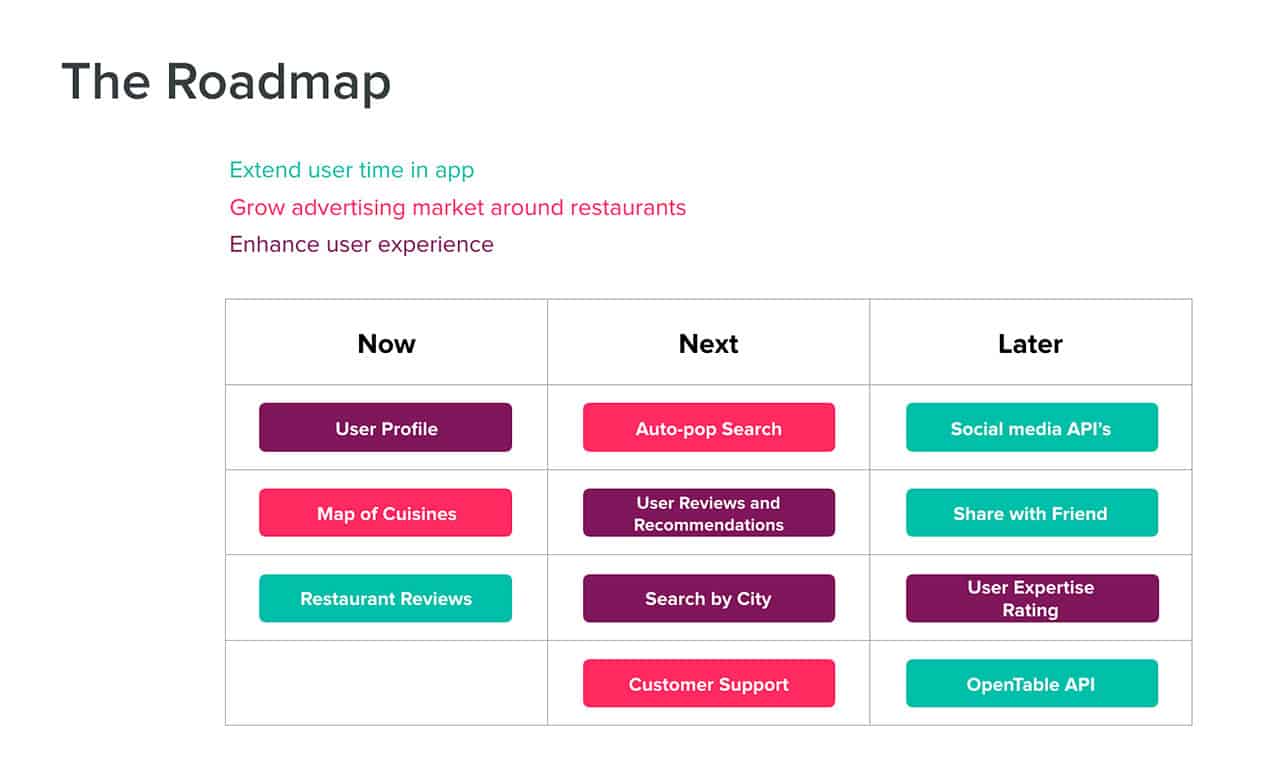What Are Product Roadmaps?
Product roadmaps are high-level summaries that help communicate the future plan for a product over time. They help to communicate to the ‘why’ behind the product, and how someone can expect it to evolve as time goes on.
A product roadmap is not only a helpful look-ahead for what’s to come, but it also builds a stronger, more concrete plan for how this strategy will be executed, by whom, and along what timeline.
Looking for step-by-step instructions on how to write a product roadmap, along with best practice tips? Visit this comprehensive article that walks you through how to create the best product roadmap for your project.
What Is a Roadmap Document?
A roadmap document is a strategic plan that outlines the goal of a project, including potential outcomes, important milestones, and all the steps and resources needed to hit the roadmap goals.
A roadmap also works as a written document to outline the strategy behind a particular plan or goal, and helps team members and key stakeholders understand the ‘why’ behind the work they are putting into a specific project.
Roadmaps are used across all industries and verticals, like IT, retail, marketing, construction, and more.
What Is a Product Roadmap in Agile?
Agile product roadmaps are used within Agile projects to define the scope of the product as it is developed, and provide insight into how a product will evolve and progress over time.
Product roadmaps are especially helpful in Agile projects because they help to narrow down the focus and the plan for the product in a very fluid manner.
Product roadmaps are used in conjunction with backlogs, which outline the product features and goals for the near future, rather than over the entire course of the project (as product roadmaps do). In Agile projects, backlogs help with smaller, more incremental tasks, and roadmaps track larger, less strict plans for the product as a whole.
For more information about Agile projects and how both roadmaps and backlogs can help in these fluid types of projects, visit this article that details are there is to know about Agile project management. Or, visit this article for specific, downloadable Agile product roadmap templates to help you get started quickly.
The Purpose of Product Roadmaps
A product roadmap is a strategic product management tool that helps a company achieve a specific business goal.
The roadmap indicates the current state of a new or developing product, plans for its future stages, and what value the final outcome will bring.
The product owner or product manager creates the roadmap and typically takes technology trends, market conditions, engineering constraints, and the organization’s value proposition into consideration. “Roadmaps need to reflect the reality of product planning, which in today’s world is far more agile than it is prescriptive,” says technologist and product manager, Cliff Gilley of The Clever PM.
In order for a product roadmap to be effective it must do more than ‘tell.’ It must also present a simple, realistic visual representation of the company’s goals for the product. Additionally, the roadmap needs to indicate a high-level execution strategy and timeline for key milestones. Lastly, Gilley recommends building a product roadmap that is adaptable. “Good product roadmaps are seen as a plan that can and will adjust as time goes on and new information is discovered,” says Gilley.
Specifically, here’s what a product roadmap can help you do:
- Share your product’s vision
- Communicate progress
- Provide visual context
- Achieve internal team engagement and stakeholder support
- Set expectations
- Secure investor funding or a budget for product development
- Make timely, smart investments in technology
- Invigorate your business
- Accomplish strategic business objectives
- Sustain your passion for greatness (AKA Continue to innovate)
What Is a Product Vision?
A product vision is the entire vision associated with a product, outlining the direction that the product plans to go as time goes on.
A product vision states what the product is at one particular moment in time, and also helps to define what the product will look like in the future.
A product vision is created mostly for the product’s end user and is therefore driven by the customers — what they need, what they want, and what a product can offer them. Product visions not only embody the product as a whole, but also the opportunities of improvement and potential roadblocks that could threaten the development of the product.
Product visions can change over time, and should be revisited after milestones and core phases of the product roadmap are met and completed. You should share the product vision with team members and the greater public to give everyone a better sense of what to expect down the line.
Product Roadmap Use Cases
Product roadmaps help developers build the best product possible, and are typically created by product owners who have a deep knowledge of the product’s functionality, features, and limitations.
Product roadmaps normally have one owner, and he or she is the only individual who has the authority to add and remove items from the roadmap.
As you build your product roadmap, keep in mind that it will likely be shared within the organization. Product roadmaps are shared with internal development teams and others who have a role in the product’s success - this could be project managers, marketing teams, and customer support personnel.
Because there is typically only one person making changes to the roadmap, some product managers choose to create uneditable spreadsheets or PowerPoints. While this method decreases the likelihood of other team members making unauthorized changes to the document, it also presents a hurdle: when changes are made, each person has to manually replace their old copy with the updated version. Down the line, it will be increasingly difficult to ensure that all team members are viewing the most current roadmap. To help ensure everyone is viewing the recent version, it’s simpler to simply post your roadmap on an internal web page. Plus, making your product roadmap accessible with collaborators and stakeholders helps you gain consensus and engagement.
External product roadmaps are usually shared with company investors, industry analysts, customers, and the media. Consider what you know about visionary technology companies:
Whether you own one of their products are not, chances are that before a new product ever hits a virtual shelf, you’ve already heard—numerous times—about what new features and capabilities the product will have. While these companies’ product roadmaps aren’t released for public knowledge, other companies have no problem publishing their product roadmaps—either for completely new products or for feature releases.
While it might seem like these companies are giving away trade secrets that might give other businesses competitive advantage, they are actually generating market interest. Publishing information on a forthcoming product helps companies build and engage with their audience. Also, when questions are answered that targeted audiences are most curious about, product demand can grow and potentially generate recommendations for future product enhancements.
Here are some examples of high-level visual product roadmaps:
Example 1: Intel Skylake roadmap
Example 2: Nick Fields PRM
Example 3: Now.Next.Later PRM
Example 4: Smartsheet Product Roadmap
Limitations of a Product Roadmap
If you are new to product road mapping and have little experience creating product roadmaps, it’s helpful to understand where a product roadmap has its limitations. Here are four things to keep in mind:
- A product roadmap is not a project plan. Remember, a roadmap is not a list of things you have committed to, promised, or guaranteed. So, if your roadmap contains a list of specific tasks and deadlines, you are accountable for those deliverables. Instead, keep your roadmap vague so that you are not committing to features or deadlines that you can’t meet.
- A product roadmap is not a Gantt chart. It’s important that you retain the high-level view in your roadmap. If your product roadmap shows the relationship among tasks, dependencies, and timelines, then you are being too granular and risk losing the goal-first perspective that drives product development.
- A product roadmap is not a release plan. You will likely base your release plan off of your roadmap, but the two are distinctly different. The roadmap does not need to include specialized resources or a specific deadline. The separate release plan will identify specific product features and explicitly indicate when those features will be available.
- A product roadmap is not a delivery. “Roadmaps can become a crutch for sales persons who can't convince customers of the value proposition or communicate your product as a solution to present problems,” says Gilley.
Product Roadmap Best Practices
Now that you grasp the full potential of a product roadmap, you are ready to start building your own. Even if you use a product roadmap example or template, you should still be mindful of best practices.
For helpful, step-by-step instructions on how to create your product roadmap, visit this article for best practice tips. Or, visit this article for a variety of different project roadmap templates that you can implement for projects that aren't as product-focused.
For a quick rundown on how to create a roadmap in Excel, you can visit our article for helpful, step-by-step instructions to get you up and running quickly.
Product Roadmap Templates
To help get you started, here are some helpful product roadmap templates for a variety of use cases that you can download and use for free to help you map out the vision of your product through every iteration.
If you're looking for additional product roadmap templates, visit our article that has 10+ templates for free download and use in a variety of formats.
Multiple Product Roadmap Template
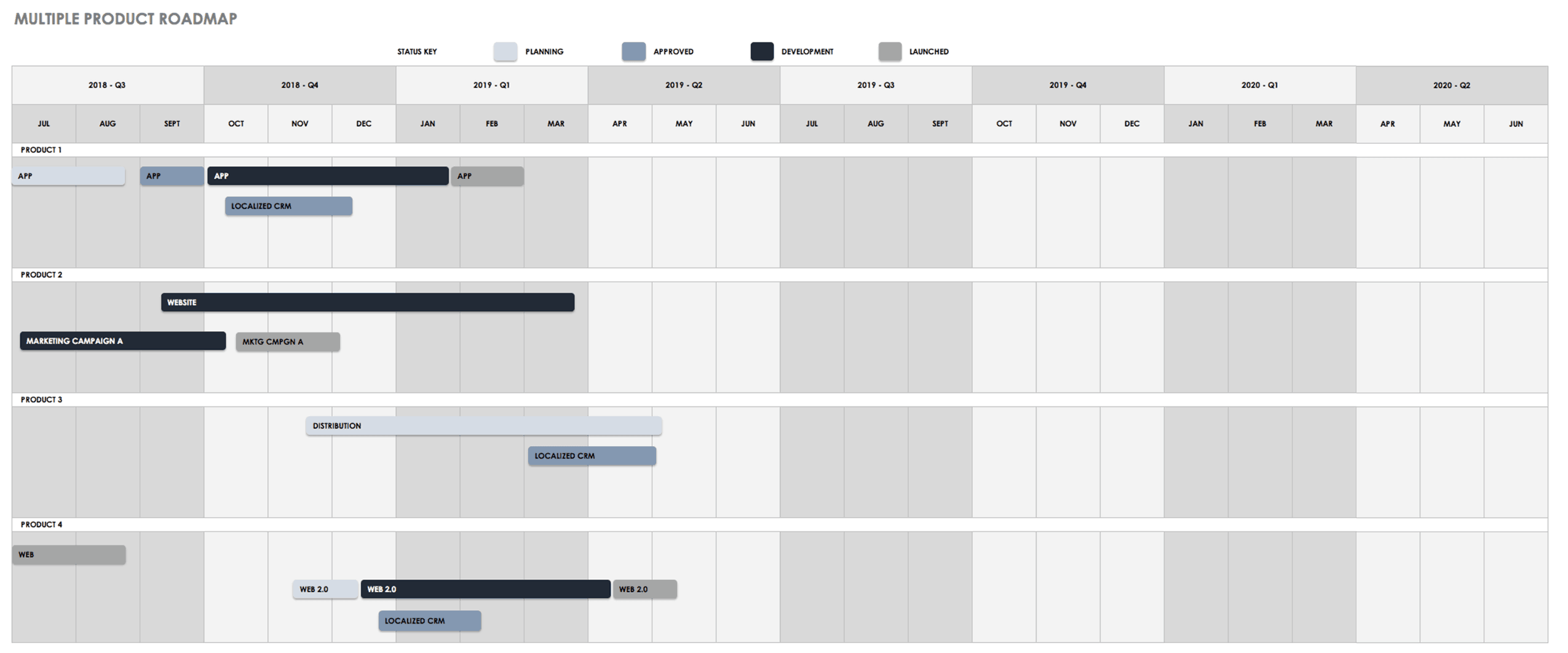
Use this product roadmap template, designed to handle multiple projects, to track how various teams are working on the product on a monthly or quarterly cadence. View how multiple product initiatives are working together, and gain insight into how they overlap so you can manage both time and resources more effectively.
Download Multiple Product Roadmap Template
Excel | Word | PowerPoint | Smartsheet
Agile Product Roadmap Template
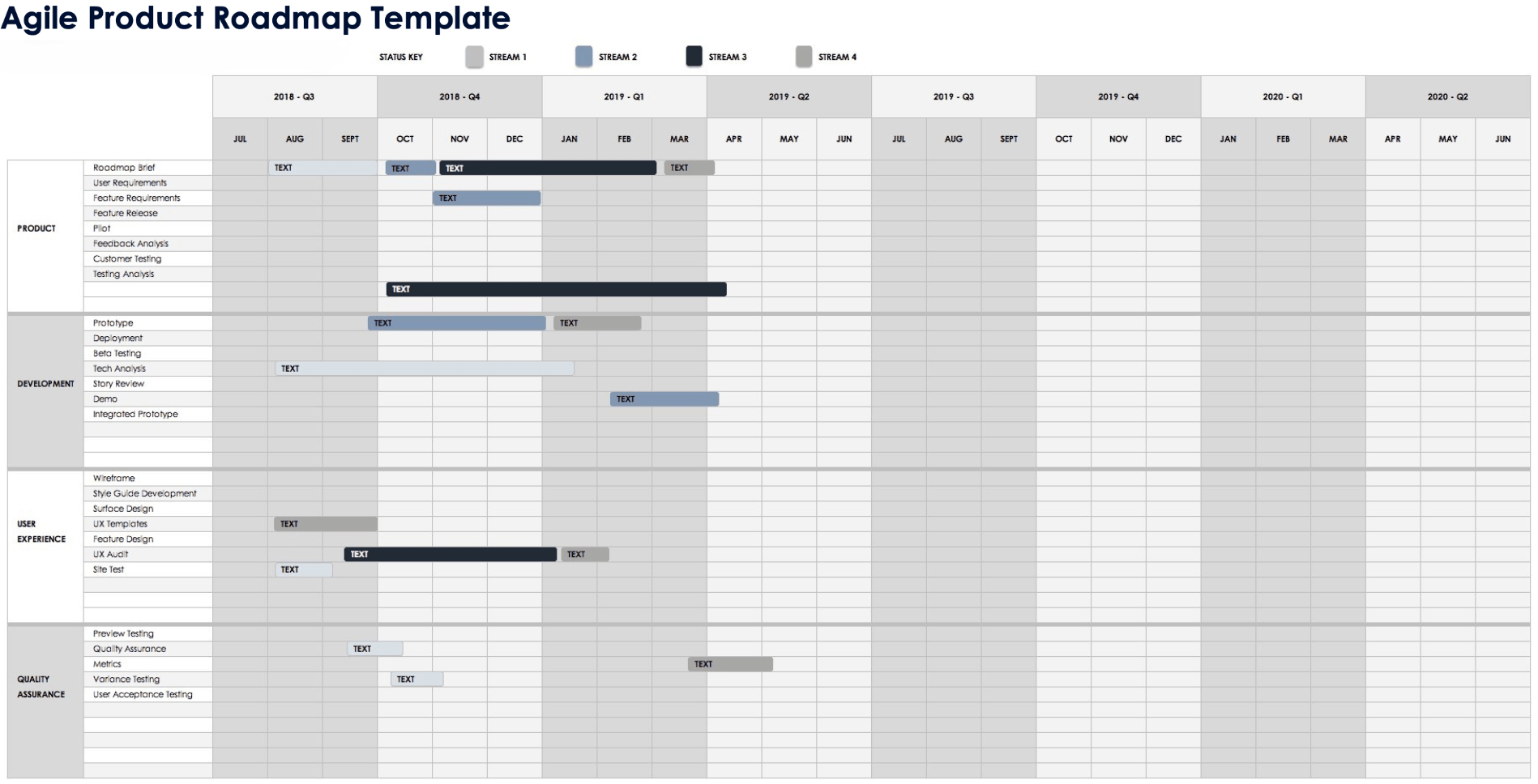
This Agile product roadmap template offers an easy way to plan, track, and manage all steps of your Agile project, with the ability to change the roadmap as your project progresses. Gain insight into key phases of your product lifecycle, and document key developments, like features, releases, and testing. This template provides guidance for your team as they work to develop a successful product.
Download Agile Product Roadmap Template
Excel | Word | PowerPoint | Smartsheet
Releases Roadmap Template

Schedule and track your product releases effectively and make sure everything is progressing as scheduled with this releases roadmap template. Ensure that all initiatives and feature releases are covered and documented, and outline testing procedures to maintain visibility into all phases of the product lifecycle.
Download Releases Roadmap Template
Features Roadmap Template
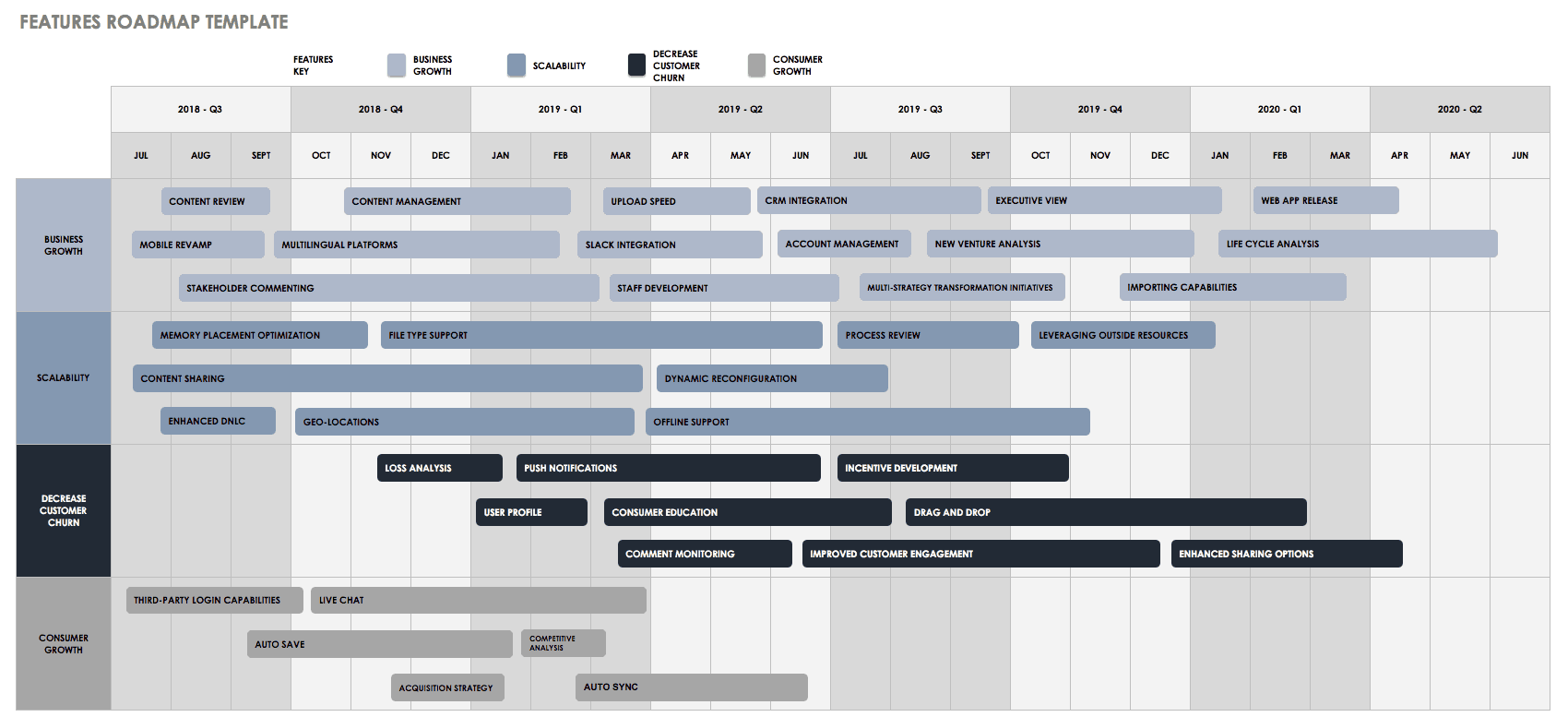
Gain insight into key feature releases and timelines with this features roadmap template. Document each feature, the date of release, and the progress of each so you can easily communicate to key stakeholders how each part of the product lifecycle is progresing.
Download Features Roadmap Template
Product Roadmap Tools
There are several online tools that can help you get started building your product roadmap. We’ve highlighted a few of the most common ones below.
- Jira portfolio: Enables companies to track initiatives across multiple Agile teams.
- Roadmap: A team collaboration tool through the Chrome browser extension that unifies data from various other SaaS tool such as JIRA, GitHub, and Basecamp .
- Slack: Instant, real-time digital communication that syncs to desktop computers and mobile devices.
- Product Plan: Visual product roadmap software that does the formatting and color coding for you.
Here are some additional resources for product roadmaps:
- Author, Steve Johnson, Look Beyond the Product: The business of agile product management
- The Clever PM, Cliff Gilley blog and website
Improve Your Product Roadmapping Efforts with Smartsheet for Software Development
Timeline view in Smartsheet empowers users to plan, visualize, and collaborate on date-based work in real-time, enabling you to effortlessly organize tasks, track progress, and communicate status.
In just a few clicks, launch your project’s timeline on any sheet to visualize your work, understand the details, and adjust information, making it easy to track project progress, detect blockers, and communicate statuses.
Discover how timeline view in Smartsheet can help your team visualize date-based work and achieve greater efficiency and transparency across projects.
Learn more about timeline view in Smartsheet.

